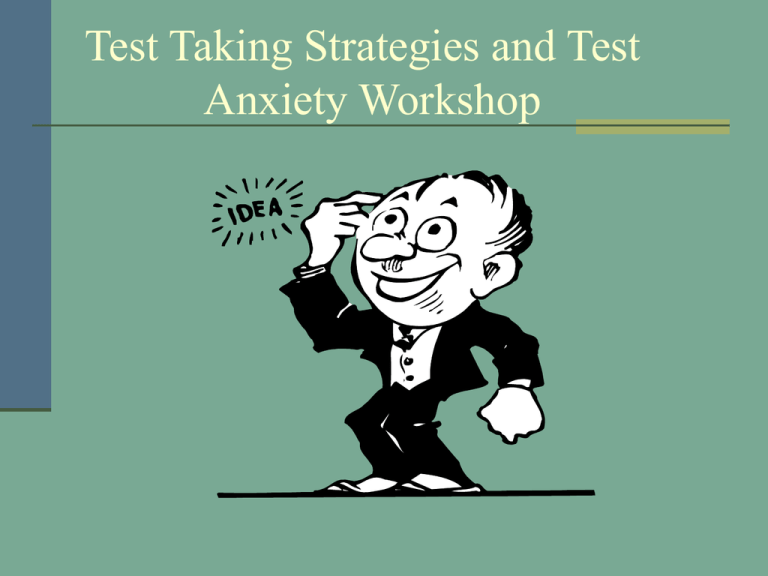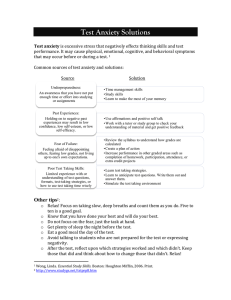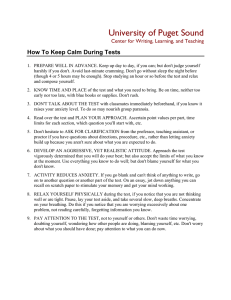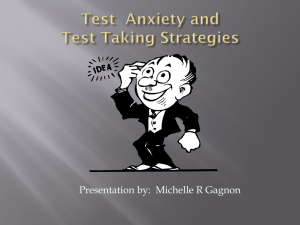Test Taking Strategies and Test Anxiety Workshop
advertisement

Test Taking Strategies and Test Anxiety Workshop What Is Anxiety? Anxiety is the feeling of agitation and distress you experience when you are faced with a challenge such as performing on stage, competing in an athletic event or taking an exam . What is Test Anxiety? Test anxiety is the feeling of nervousness and distress you experience before or during an exam. Students who suffer from test anxiety report difficulties with concentration, mental blocks, and distractibility. There Are Two Types Of Anxiety: Anticipatory: feeling of distress occurring while studying for or thinking about the exam. Situational: feeling of distress occurring while taking the exam. It is important to be aware of when anxiety attacks you so that you may use strategies in and out of the exam situation to manage the anxiety. Test anxiety occurs in a wave so it will increase from when you first recognize it, come to a peak, and then subside. Peak What causes test anxiety? •Lack of preparation! •Past experiences of blanking out or performing badly on exams. •Focusing too much on the outcome. •Focusing too much on how other classmates and friends are doing. •Issues outside of school distracting you from studying for or concentrating on exam. How does test anxiety affect you? Test anxiety affects you in three ways: Physiologically Behaviorally Psychologically Physiological reactions may include: - increased heartbeat - tensed muscles - perspiration - dry mouth Behavioral reactions may include: - Inability to make decisions, act, or express yourself. - Difficulty reading and understanding questions on an exam. - Difficulty organizing your thoughts. - Difficulty recalling or retrieving terms and concepts. Psychological reactions may include: - Feeling apprehensive or uneasy. - Feeling upset. - Having self-doubt or negative self-talk. What are some ways to deal with test anxiety before the exam? How can you prepare well and in advance? -Gather information about the exam. -Set up a study schedule. -Review material often throughout the semester. -Test yourself. Gather information about the exam To gather information about the exam ask: -What kind of test am I going to take? -How much time will I have? -What material will be covered? -How will the test be graded? Set up a study schedule Put specific study times into your schedule and determine study tasks for each review session. Below is an example of a student’s review schedule one week before exam: Weekend Monday Tuesday Thursday Friday Gather materials – old exams, notes, and homework. Study chaps. 1,2 Review chaps. 1,2;study 3 & notes Review chaps 1,2,3; study 4 & notes Put hard to remember material on a master study guide. Final review of study guide. Review material effectively and often throughout the semester. -Conduct review sessions 10 minutes a day for each class. Seeing, hearing, or interacting with the class material often will help you remember it. -Study in short spurts (an hour or less) and take breaks, rather that studying straight through for several hours. -Aim for understanding the material, not just memorizing. Test Yourself : -Making flash cards. -Using chapter tests in your textbook. -Turning each section heading into a question and then trying to answer it. -Looking away from each section you are studying and reiterating (to yourself or a study partner), verbally or in writing, what that section is about. How can you check your attitude before the exam? -Change negative self-talk into positive self-talk. For example, if the voice in your head says: “I’ve never been good at Math. I’m going to fail this exam!” Change it to: “Math is not my best subject but if I practice and ask questions, I’ll be okay.” -Keep in mind that one exam is unlikely to make or break your whole future. -If issues outside of school distract you, jot them down on a piece of paper so you can come back to deal with them later. For chronic anxiety or depression, talk to a professional. Relax Learn stress releasing strategies that you can use in and out of the exam situation. Practice the techniques so they become easy to use. Following are Quick Relaxation Techniques you can use in or out of the classroom: TENSE AND RELAX If sitting in a chair in class, you can use your chair to help you with this exercise. • Place your feet flat on the floor in front of you. • With both hands, grab the underside of your chair. • Push your feet into the ground and pull on your chair upward. Tense your muscles, holding for 5 seconds. • Release your pull and relax your feet, letting your body go limp. • Repeat as necessary. BREATHE 3 Deep Breaths • Inhale through your nose, taking in air as if filling your abdomen. •Hold for 1 second. •Exhale through your mouth or nose, slowly (make sure you exhale completely – push out every last bit of air). •Repeat two more times. Body Scan • Start at one end of your body and focus on a specific muscle or muscle group. • Concentrate on how that muscle feels. Is it tense? • Consciously release the tension in the muscle. • Continue throughout your entire body. Guided Imagery •Imagine that you are going away from where you are right now and traveling to a place where you want to be. This place may be a warm beach, a tropical forest, a cozy room, a pool of water…you decide. •What does this place feel like? - Is it warm or cool? Are there soothing breezes or comforting sun rays? - Is there a refreshing mist or shower of rain? - Is it bright or dim? What kind of light is there? – Daylight? Candlelight? Moonlight? •What aromas does this place have? – Spring flowers? Pine trees? Citrus fruits? Salty seaside air? Fresh cut grass? Coffee? Mint? •How does this place make you feel? – Peaceful? Tranquil? Refreshed? Beautiful? Strong? Confident? Whatever the feeling, embrace it; hold on to it. •Now as you journey back to here, hold on to that feeling and bring it back with you. What strategies can you use to relieve anxiety during the exam? Here are some student suggestions: Take a break. Stop for a minute, role your shoulders or close your eyes. Get a drink of water. See if you can leave the room for a drink of water so you can briefly leave the exam environment. Ask a question. Break the uncomfortable silence by asking the instructor a question. Move on to an easier question. If being stuck on a question is frustrating you, move on and come back to the challenging one later. Use positive self-talk. Talk to yourself and guide yourself out of the anxiety. Use your quick relaxation exercises. Allow yourself a time out – take a few breaths, tense and relax, or do a quick stretch. Three Stages Of Test Taking: Before the exam During the exam After the exam Before the exam: Remember to gather information about the exam. Prepare well through setting a study schedule, reviewing often, and testing yourself. Get rest and eat well. Know strategies for different test types – multiple choice, short answer, matching, and essay. Multiple Choice Exams •Read directions carefully. Most items ask for single answers but some may give you the option of marking several choices. •Read each question thoroughly, then look at the choices. •Underline key words and phrases. If the question is complicated, break it down into small or simple sections that are easier to understand. •Pay attention to qualifiers. Words such as “only” or “except” or negative words such as “not” can confuse your understanding of what is being asked. •Eliminate answers you know are incorrect. Check relevancy and accuracy of each answer. •Look for patterns that may lead you to the answer. Sometimes choices that are more general or are of a middle value in a range may indicate a right answer. •Read every word of each choice. Instructors may include answers that are right except for a single word. •When a test includes a long reading passage, read questions first. This might help you focus on the information you need to answer the questions. Matching Exams •Read directions carefully. Sometimes an instructor may want you to consider an answer only once; other times an instructor may want you to consider an applicable answer more than once. •Start with the column that has the longest statements and match those with shorter statements or terms. •Do easy matches first to eliminate possible answers and make it easy to spot the more difficult matches. Short Answers Exams •Look for clues. The sentence structure or number of blanks may give you clues to the answer. •Don’t look hard for hidden meaning. Short answer questions are meant to test your ability to recall information.. •Over-answer. If you are stuck with two answers, write down both – you might get partial credit. True/False Exam •Check for qualifiers. •Words such as all, always, only and never tend to indicate an absolute. This may indicate a false answer. •Words such as generally, usually, often, and sometimes may indicate true answers. •Look for two-part statements. If one part of the statement is incorrect, the whole statement is false. •Don’t look hard for hidden meaning. Essay Questions •Survey exam. Read all questions and decide how much time you will spend on each. •Analyze each question carefully. Understand what the question is asking. For example, is the question asking you to compare ideas or describe a situation? Underline key terms and phrases. Look for phrases that limit the topic such as “Between 1815-1830…” or “In the western part of …” •Plan before you begin writing. Write down main ideas and examples and create an outline. •Write your answer using your outline and fill in details. •Review. Do a final check. Did you answers all parts of the question? Check for spelling and punctuation errors. During the exam: Do an information dump! Before you begin answering, jot down hard to remember formulas and terms on the margins or back of exam. Survey exam. Before you begin answering, take a quick look at the whole exam. This may help you decide where to begin and how much time to spend on each question. Read directions carefully and underline key terms and phrases. Do easy questions first. They may give you clues for the more challenging questions. Relax! Use your strategies to calm yourself. After the exam: Reward yourself! Keep practicing positive self- talk. Analyze your exam. •What went well and what didn’t? •What type of questions did you find most challenge? Why? Make and implement a plan to do better next time. Set Goals For Change: List test taking or study strategy ideas you think might help you perform better on exams. Then decide how and when you will implement them. In order to improve my test taking skills I will work on: __________________________________________________ __________________________________________________ List two test taking or study skills you will incorporate this week: 1)______________________ How?__________________ 2_______________________How?__________________ List two test taking or study skills you will incorporate this semester: 1)______________________How?___________________ 2)______________________How?___________________




